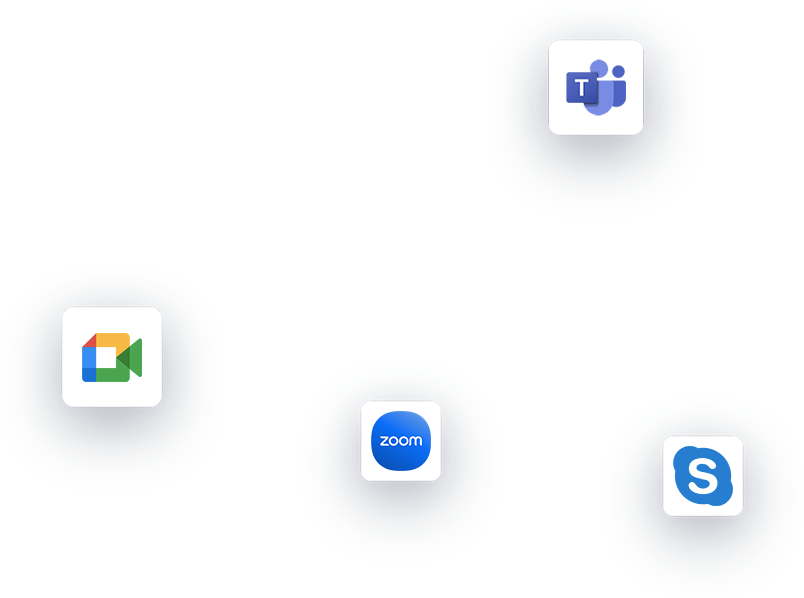Meeting Transcription
Smart Scribe uses AI to transform your meeting recordings into impeccably written transcripts.
As every word matters, our meeting transcription solution converts your meeting recordings into precise transcriptions you can quickly refine.
Smart Scribe enhances team collaboration and productivity by eliminating manual note-taking during meetings
and the need for manual transcription post-meeting.

In an ever-evolving modern working world, the shift towards remote work – accelerated with the COVID-19 pandemic – has led to a significant decrease in face-to-face meetings and fostered the holding of remote sessions. Virtual meetings are progressively becoming a standard as they allow to bridge geographical distances and provide more flexibility and convenience while complying with health recommendations during the pandemic. Hence, those virtual meetings present significant advantages in a world where agility and efficiency are paramount, at a time when businesses seek to improve the productivity of their staff while also aiming to fulfill their aspiration for a better work-life balance. However, with this shift comes the challenge of effectively capturing and documenting the discussions and exchanges, and this is where the fundamental role of meeting transcription comes in.
Transcribing meetings is necessary to preserve the critical decisions and insights emerging from these discussions. In a world where speed and responsiveness are essential and where every conversation can impact decision-making, accurate transcription of meetings becomes an absolute necessity. It’s not just about keeping a record; it’s about maintaining high-quality active communication, ensuring continuity, and guaranteeing all participants access to the same information regardless of their working location.
In a world where time is a valuable commodity, Smart Scribe offers an innovative solution transforming how businesses transcribe their meetings by providing an efficient, accurate, and seamless way to convert spoken words into written formats, thus bridging the gap between verbal discussions and written records. Together, let’s explore the importance of meeting transcription needs in today’s business landscape, highlighting the challenges of traditional methods and the advantages of automatic transcription solutions like Smart Scribe.
The Importance of Meeting Transcription in the Remote Work Era
Meeting transcription has become increasingly significant in an era where remote work is becoming the norm. With team members often dispersed across various locations, capturing every discussion in written form ensures no vital information falls through the cracks. It’s not merely about documenting words but preserving the essence of collaborative efforts and facilitating effective follow-up.
Transcription serves multiple pivotal roles in the remote work landscape. Firstly, it acts as a reliable reference point. Recalling details or finding specific information from an audio or video recording can take time and effort. Written transcripts, however, offer a quick and accessible way to revisit main points, decisions, and action items discussed during meetings or search for particular information. Meeting transcripts are particularly beneficial in complex projects involving precise details and technical discussions.
Secondly, transcriptions aid in maintaining inclusivity. Often, only some invitees can participate in a meeting, while the rest cannot attend due to time zone differences or other commitments. Transcriptions ensure that these individuals who cannot participate remain informed and can still contribute later on at their convenience. Moreover, written records are vital for the comprehension and participation of non-native speakers or individuals with hearing impairments.
Furthermore, meeting transcripts also serve legal and compliance purposes. In many industries, keeping detailed records of meetings is not only a convenience but a regulatory requirement. Meeting minutes must faithfully record what was discussed and agreed upon and can be particularly useful in a legal or auditing context.
Therefore, transcription is crucial in the remote work era. It enhances communication, ensures accountability, and fosters a more inclusive and compliant work environment. By providing a clear and accurate record of meetings, businesses can ensure continuity in their operations and decision-making processes, irrespective of their teams’ physical locations.
Challenges of Manual Transcription


While the benefits of transcribing meetings are clear, the traditional approach of manually transcribing an audio recording into text is challenging. This process is inherently time-consuming and labor-intensive, often requiring work hours to transcribe a single meeting. The workload can be a significant drain on resources, especially for businesses with frequent and lengthy meetings.
One of the primary challenges of manual transcription is the risk of human error. Mishearing, misinterpreting, or even missing parts of the conversation can lead to inaccurate transcript information. These errors can be particularly problematic if they relate to critical business decisions or technical discussions where precision is fundamental.
Another challenge is the turnaround time. Manual transcription generally takes several times the length of the meeting, resulting in delays in disseminating the information to the team. In a fast-paced business environment, these delays can be detrimental, slowing decision-making processes and response times.
Moreover, manual transcription requires a specific skill set. It’s not just about typing speed; it also involves understanding the context, mastering industry-specific jargon, and distinguishing between speakers. Finding individuals with the right combination of skills and who are available when needed can be challenging and costly for businesses.
There’s also the issue of scalability. As a business grows and the volume of meetings increases, so does the need for transcription. Relying solely on manual processes can quickly become unsustainable, leading to backlogs and increased pressure on transcription staff.
In summary, while manual transcription can provide accurate records of meetings, the process is riddled with pitfalls that can hinder a business’s efficiency and productivity. These challenges stress the need for a more efficient, reliable, and scalable solution for meeting transcription.
The Benefits of Automatic Transcription for Businesses
Adopting automatic transcription solutions like Smart Scribe brings numerous benefits to businesses. These solutions transform how meeting insights are captured and utilized, going beyond time and cost savings to enhance overall business operations and communication.
Future of Meetings: The Role of AI and Automation
The future of meetings will be closely related to the advancements in artificial intelligence (AI) and automation. Smart Scribe is undoubtedly at the forefront of this transformation and craves to embrace this near future by leveraging cutting-edge technology and AI advancements to incorporate more sophisticated features and reshape how we approach meetings.
At Smart Scribe, we firmly believe AI’s potential in meetings extends beyond simple transcription. For example, future developments could automatically extract relevant information and identify next steps to generate meeting minutes, assess participant engagement, or suggest future meeting agendas and focus areas.
As automation becomes more prevalent, meeting efficiency and effectiveness will continue to improve. AI-powered online solutions like Smart Scribe will become indispensable in managing the complexity and volume of business communications, driving productivity and innovation.
Smart Scribe aims to pave the way for more intelligent, impactful, and productive meetings by constantly adapting itself to fully satisfy the needs of the ever-changing landscape of modern business.
Today, more than ever, businesses must keep up with the constantly evolving demands of remote work and digital collaboration. To address these challenges, Smart Scribe has emerged as an innovative solution. It combines AI-advanced technology with a user-centric approach to revolutionize how businesses harness and leverage the content and insights from physical and virtual meetings.
Smart Scribe helps businesses to extract meaningful insights from their meetings efficiently. With Smart Scribe, meeting recordings are transformed automatically into editable written content, eliminating the struggle of note-taking and the need for manual transcription. It lets participants focus on the discussion without distractions and makes it easy to derive actionable insights post-meetings, boosting productivity and facilitating decision-making. Additionally, meeting transcriptions allow for consolidating all discussions, decisions, and action points into a central, searchable repository for future reference. This results in improved knowledge management and continuity within the organization.
Smart Scribe meets the demands of businesses worldwide, making international collaboration smooth and easy thanks to its ability to automatically transcribe audio and video files in more 30 different languages, thus broadening its applicability and utility globally. It also promotes accessibility and inclusivity by providing written transcripts that answer the needs of individuals who are hard of hearing, non-native speakers, or those who prefer to glance over meeting outputs rather than listen to entire recordings. Hence, it fosters inclusive work environments and ensures that every voice, irrespective of linguistic or physical limitations, is acknowledged and valued.
As businesses worldwide continue to shift towards remote work and digital collaboration, technology solutions like Smart Scribe become undeniably strategic. Smart Scribe is not just a tool for transcription; it is a catalyst for transformative business practices, enabling enhanced communication, strategic decision-making, and global collaboration. Adopting Smart Scribe positions businesses at the forefront of this shift, ready to thrive in an increasingly connected and dynamic world.





